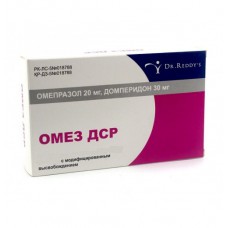Expiration date: 01/2026
Structure
active ingredients: omeprazole, domperidone,
1 capsule contains omeprazole 20 mg (in the form of intestinal-soluble pellets), domperidone 30 mg (in the form of pellets of prolonged action),
excipients of intestinal pellets: mannitol (E 421), lactose, monohydrate, sodium lauryl sulfate, sodium hydrophosphate anhydrous, sucrose, hypromellose, methacrylate copolymer (type C), talc, sodium hydroxide, polyethylene glycol 6000, titanium dioxide (E 171),
excipients of pellets of prolonged action: nonpareil (a mixture of sucrose/starch), colloidal anhydrous silicon dioxide, hypromellose, talc, ethylcellulose, triacetin, iron oxide yellow (E 172), iron oxide red (E 172), titanium dioxide (E 171).
Dosage form
Modified release capsules, solid.
Basic physical and chemical properties: solid transparent colorless gelatin capsules no. "1" with black marking on the capsule lid and red marking "OMEZ-DSR" on the capsule body. The contents of the capsules are spherical pellets from almost white to grayish and from yellowish – brown to brown.
Pharmacotherapeutic group
Drugs for the treatment of acid-dependent conditions.
ATX code A02X.
Pharmacological properties
Pharmacodynamics. A combined medicinal product, the effect of which is due to the components that make up its composition.
Omeprazole is an anti-ulcer agent that inhibits basal and stimulated hydrochloric acid secretion in the parietal cells of the stomach due to its specific action on H+ - K+-ATPase (proton pump). The antisecretory effect after taking omeprazole develops very quickly within the first hour and persists throughout the day. Omeprazole, due to its high lipophilicity, easily penetrates the parietal cells of the stomach, concentrates in them and has a cytoprotective effect. The inhibitory effect increases in the first 4 days of administration. Inhibition is dose-dependent. Daily intake of omeprazole in doses of 20 mg and higher provides a stable and effective control of acidity.
Omeprazole does not affect the motility of the gastrointestinal tract.
Omeprazole (replaced by benzimidazole) inhibits the intestinal enzyme H+, K+-ATPase (proton pump), which catalyzes the exchange of H+ and K+ions. Since this enzyme is considered an acidic (proton) pump of the gastric mucosa, omeprazole is characterized as an inhibitor of the gastric acid (proton) pump. Omeprazole effectively inhibits basal and stimulated hydrochloric acid secretion with an extended duration of action. The degree of inhibition of gastric secretion of hydrochloric acid by omeprazole correlates with the area under the "plasma concentration - time" curve and does not have a direct relationship with the plasma concentration of the drug at one specific time point.
Domperidone is a dopamine antagonist that acts as a prokinetic on the upper gastrointestinal tract and increases the tone of the lower esophageal sphincter and accelerates gastric emptying. The drug does not cause dopamine antagonistic effects on the Central nervous system, probably due to the inability to penetrate the blood-brain barrier. The drug increases the activity of the smooth muscles of the gastrointestinal tract by inhibiting dopamine in the D1 receptors. Dopamine effectively enhances esophageal peristalsis and increases the pressure of the lower esophageal sphincter, stimulates motility and gastric peristalsis, improves gastroduodenal coordination and, as a result, accelerates gastric emptying.
Domperidone blocks peripheral dopamine receptors, eliminates the inhibitory effect of dopamine on the motor function of the gastrointestinal tract and increases the evacuation and motor activity of the stomach. It has an antiemetic effect, soothes hiccups and eliminates nausea. Poorly penetrates the blood-brain barrier, practically does not affect the dopamine receptors of the brain.
Pharmacokinetics. Omeprazole is rapidly and completely absorbed after ingestion on an empty stomach, when taken after a meal, the absorption process may be prolonged. Although the half-life of omeprazole is short (0.5-1.5 hours), the antisecretory effect persists for 24 hours or more. Approximately 90-95 % of omeprazole binds to plasma proteins. A limited amount of omeprazole penetrates the blood-brain barrier. The majority (77 %) is excreted in the urine as metabolites (of which hydroxyomeprazole and the corresponding carboxylic acid were identified), the rest is excreted in the feces (which implies significant excretion of metabolites with bile).
In patients with chronic liver disease, the bioavailability of the drug increases to 100%, and the half-life increases to 3 hours. In patients with chronic kidney disease and in elderly patients, omeprazole elimination decreases in proportion to the decrease in creatinine clearance, and the concentration in blood plasma increases.
Omeprazole is sensitive to degradation in the acidic environment of the stomach, so a dosage form of enteric granules in a capsule was developed for this drug. Food does not affect the bioavailability of the drug. Bioavailability is reported to be about 40% after taking 20-40 mg doses. The time to reach the maximum plasma concentration is 0.5-3.5 hours. Omeprazole in capsules is completely and rapidly metabolized, since the original compound was not detected in feces or urine. The main enzyme involved in the metabolism of omeprazole is the polymorphically expressed isoform of cytochrome P450 (CYP) – S-mephenitoinhydroxylase, CYP2C19. The plasma half-life does not change significantly after repeated administration. Despite the rapid elimination (average half-life from 0.5 to 1 hour), the antisecretory effect of omeprazole is long-lasting due to its pronounced affinity for the acidic state of parietal cells.
Domperidone is well absorbed after taking the drug. It undergoes intensive metabolism in the stomach wall and in the liver, and has low bioavailability (15 %). The maximum concentration in the blood plasma is reached 1 hour after application. The total plasma clearance is about 700 ml/min. The half – life after intravenous administration is about 7.5 hours, while after oral administration it is about 14 hours. Domperidone is secreted in bile mainly in the form of active metabolites. About 30% of the dose is excreted in the urine within 24 hours, almost entirely in the form of metabolites, and the rest is excreted in the feces within a few days (about 10% ? in the form of an unchanged drug). Domperidone penetrates into breast milk in small amounts. Reducing the acidity of gastric juice reduces the absorption of domperidone. Binds to plasma proteins by 91 - 93 %. The half-life is about 9 hours, with severe renal failure, the half-life increases.
Indications
Short-term treatment of acid-dependent diseases accompanied by nausea,
treatment of gastritis or gastroesophageal reflux disease accompanied by vomiting.
Contraindications
Hypersensitivity to the components of the drug, hypersensitivity to substituted benzimidazoles.
Period of pregnancy and lactation, children under 12 years of age.
Omeprazole, like other proton pump inhibitors (PPIS), should not be used simultaneously with nelfinavir (see "interaction with other drugs and other types of interactions". Simultaneous use of other drugs that prolong the QT interval or enhance CYP3A4 inhibitors, severe or moderate liver and/or kidney function disorders, liver failure, prolongation of cardiac conduction intervals, in particular the QT interval, which is the basis of heart disorders or diseases, severe electrolyte imbalance, prolactinoma.
Do not use if stimulating the motor function of the stomach may be dangerous, for example, with gastrointestinal bleeding, mechanical obstruction or perforation.
Concomitant use of ketoconazole, erythromycin or other potent CYP3A4 inhibitors, drugs that prolong the QT interval, such as fluconazole, erythromycin, Itraconazole, oral ketoconazole, Posaconazole, ritonavir, saquinavir, telaprevir, voriconazole, clarithromycin, amiodarone, telithromycin, is contraindicated.


